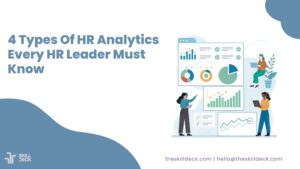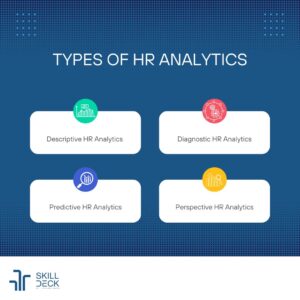4 Types Of HR Analytics Every HR Leader Must Know

We all love Guesswork. It is the fastest way to decide on anything, especially in the early days of a business when you have less data to work with. However, you will find yourself wanting more data-driven investigations as your workforce size expands, with people filing new job openings in a growing organisation.
Human resource teams rely on different types of HR Analytics when they have to manage large, interconnected departments in the organization. HR analytics uses historical and present data to analyse employee turnover, performance, satisfaction, and engagement patterns. The insights help them boost employee productivity through strategic solutions, which ultimately benefits the company’s productivity.
A company’s HR team will employ four types of HR analytics: they are descriptive, diagnostic, predictive, and prospective.
As the top HR certification provider in India, we provide hands-on HR analytics training to beginners and working professionals. This makes us the right authority to provide an in-depth understanding of different HR analytics types and their workplace applications.
What Is HR Analytics?
HR Analytics is the strategic use of converting workforce data into insights that can be used to boost employee performance, satisfaction, and retention, and drive business growth.
HR Analytics helps HR leaders take smarter actions by analyzing recruitment trends, retention rates, and employee engagement. It is a set of practices that turns raw HR data into actionable intelligence, which uncovers patterns and predicts outcomes. This significantly improves hiring, training, productivity, and culture.
Successful implementation of different types of HR analytics turns human resource management from a reactive to a proactive function that contributes to business success. With HR analytics, companies don’t just recruit people; they understand them, thus aligning their employee strategies to organizational goals.
What Are The 4 Types Of HR Analytics and Their Interview Focus?

Descriptive HR Analytics
HR professionals use Descriptive Analysis, also known as Decision Analytics or basic analytics, to understand everything that has happened throughout the years. It leverages historical metrics and trends related to hiring rate, employee performance, office demographics, retention levels, and productivity to gain a perspective of what is happening in the present.
Descriptive analysis has minimal implications on the future but lays the groundwork for other types of HR analytics.
Descriptive HR analytics is necessary to understand the present workforce state. It offers clear insights that HR leaders can use for advanced analytics. Descriptive HR analytics also identifies areas that need more attention.
Interview Focus: Using past data to understand current workforce trends.
Diagnostic Analytics In HR
Amongst the HR Analytics types, diagnostic analytics is more precise in finding the reasons behind why something is happening. It is not just about uncovering issues in the workplace but also going a step further to identify the root cause of the problem, event, or results.
Diagnostic analytics is an extension of descriptive Analytics. HR professionals leverage historical metrics to study emerging patterns and trends related to certain events. They also check other unknown factors that have/will influence the event.
For instance, if there is rising employee dissatisfaction in the workplace, then diagnostic HR Analytics can help leaders identify why this is happening. Is it longer hours, tight deadlines, unsatisfactory pay, insufficient career growth etc.
Depending on the reasons, they can propose solutions to boost employee satisfaction.
Interview Focus: Leveraging data to understand the cause of an event and finding solutions.
Predictive HR Analytics
Unlike descriptive and diagnostic HR analytics types, which focus on the past and present, predictive HR analytics is for the future.
HR experts used this technique to answer questions like “what event will happen months or years from now?”, “What factors will cause the event?” and “What is the best course of action?”.
For example, HR teams can predict future employee turnover rates by analysing employee survey responses and performance reports. Predictive analysis data pinpoints high-performing employees and why they risk exiting the company in the future. The insights help HR teams implement suitable solutions to retain top talent.
Besides employee retention, predictive analysis also helps in –
- Recruiting the best talent in the market by forecasting the retirement rate
- Reducing employees’ skill gap with training by predicting upcoming technology trends
- Planning flexible and inclusive office spaces by predicting future remote or hybrid workforce trends.
Interview Focus: Use of past and present data to predict future events.
Perspective Analytics In HR
Perspective analytics is an extension of predictive analysis where the primary focus is on actions and outcomes instead of just prediction. It is considered the most advanced and complex of all HR analytic types because it relies heavily on big data for solutions.
An HR executive conducting predictive analytics leverages different tools like artificial Intelligence and machine learning to identify patterns. The resulting insights from multiple sources help them answer questions like What Needs To Be Done? and What are the more effective strategies?.
Interview Focus: Using data to find solutions for future events.
You can check out our HR Analytics Certification Course, where our educators will help you gain mastery over all types of HR Analytics.
